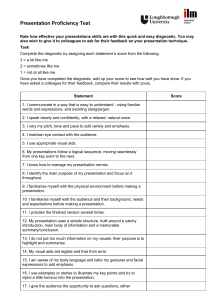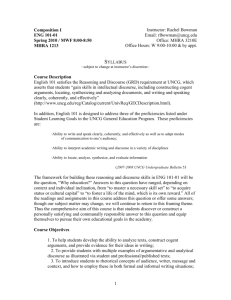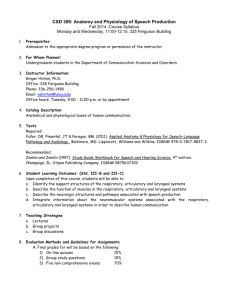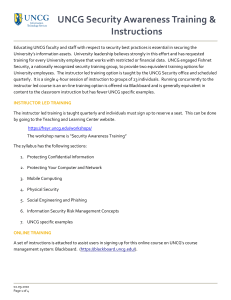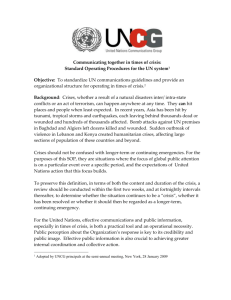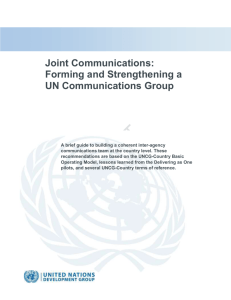speech and language disorders: diagnostic procedures
advertisement
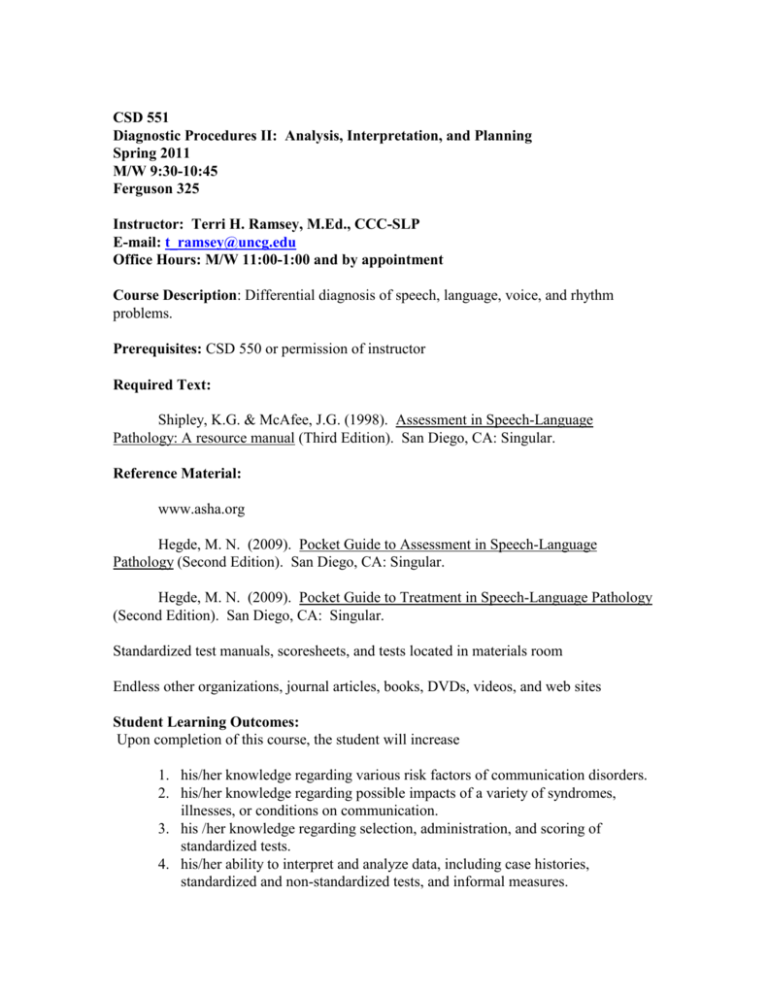
CSD 551 Diagnostic Procedures II: Analysis, Interpretation, and Planning Spring 2011 M/W 9:30-10:45 Ferguson 325 Instructor: Terri H. Ramsey, M.Ed., CCC-SLP E-mail: t_ramsey@uncg.edu Office Hours: M/W 11:00-1:00 and by appointment Course Description: Differential diagnosis of speech, language, voice, and rhythm problems. Prerequisites: CSD 550 or permission of instructor Required Text: Shipley, K.G. & McAfee, J.G. (1998). Assessment in Speech-Language Pathology: A resource manual (Third Edition). San Diego, CA: Singular. Reference Material: www.asha.org Hegde, M. N. (2009). Pocket Guide to Assessment in Speech-Language Pathology (Second Edition). San Diego, CA: Singular. Hegde, M. N. (2009). Pocket Guide to Treatment in Speech-Language Pathology (Second Edition). San Diego, CA: Singular. Standardized test manuals, scoresheets, and tests located in materials room Endless other organizations, journal articles, books, DVDs, videos, and web sites Student Learning Outcomes: Upon completion of this course, the student will increase 1. his/her knowledge regarding various risk factors of communication disorders. 2. his/her knowledge regarding possible impacts of a variety of syndromes, illnesses, or conditions on communication. 3. his /her knowledge regarding selection, administration, and scoring of standardized tests. 4. his/her ability to interpret and analyze data, including case histories, standardized and non-standardized tests, and informal measures. 5. his/her skills in finding relevant research and literature related to particular disorders. 6. his/her skills at demonstrating effective speaking during oral presentations. 7. his /her knowledge of the formal diagnostic process and specific assessment procedures. Course Requirements: 1. Class Attendance and Participation. As this is a preprofessional class, please do not sign up for this class if you will be unable to attend regularly. Attendance will be taken daily, and absences will directly impact your grade. Medical and family emergencies will be the only excused absences. Further, active participation is expected daily. If you feel you will be unable to contribute on a regular basis to discussion, please do not take this class. Students will have input in each other’s participation grades several times throughout the semester. 2. Risk Factor Assignment. Each student team will choose a potential risk factor of communication impairment. The team will research the topic and prepare a 1-2 page summary explaining why this would be a risk factor for communication impairment and addressing possible implications for speech, language, or feeding/swallowing. A reference list should be included with at least three current, professional journal articles and at least three websites. The team should be prepared to share information during class discussion. Teams will be asked to post their summaries on Blackboard for class members to access. 3. Oral and Written Presentations (Syndromes, Illnesses, Conditions). Student teams will research and read topic related information in print, video and on the Internet and prepare a 30-40-minute professional multimedia presentation for class. Interviews with families or individuals, as well as with educators or health care providers are expected. Professional dress and presentation skills will be required. In addition, each student team will prepare a thorough handout about their topic area(s) to be turned in and shared with all class members. A comprehensive reference list will be included including at least four internet references and at least three current, professional journal articles must be included. ***Included in the written summary (to be sent to Mrs.Ramsey for posting on Blackboard one class period prior to presentation) should be a description/definition and list of identifying characteristics. Focus of the oral presentation should be a) possible communication impact b) pertinent therapeutic considerations **Each team will also provide the class members with a handout on the day of the presentation focusing on the communication impact and the therapeutic considerations. **Teams are responsible for making arrangements for copying prior to their presentation. 4. Diagnostic Observation Presentation and Write-up – All student teams will observe one complete speech and/or language diagnostic. This will include attending meetings between clinicians and supervisors prior to, and following, the evaluation, This process typically includes: one Diagnostic planning meeting, the Dx itself, the staffing following the Dx, and the Reporting conference at the UNCG Speech and Hearing Clinic. Each student team will prepare a written summary of the diagnostic, including all formal and informal measures used. Student teams will share thoroughly these cases with the class during a formal presentation. Again, professional dress and speaking skills will be expected. The presentation will take one entire class period. 5. Test Presentation - Each student or team will study one assessment tool thoroughly and present it to class. This includes knowing when a clinician would choose to administer the instrument, specific domain(s) measured, and how results might be interpreted. For example, if a client did poorly on this section..what could it mean? If a client scored well on this part, but did poorly on this part…what could it mean? 6. Scoring and Interpretation of Tests - all students will score and interpret various tests and complete checklists confirming his/her active participation in each assessment presentation. Grading: 1. Risk Factor Assignment (SLO 1,5,6) 2. Presentation on Syndrome/Condition/Disorder (SLO 2,5,6) 3. Diagnostic Observation: Presentation and Write-up) (SLO 1, 2, 3, 4, 5, 6,7) 4. Scoring and Interpretation of Tests 5. Test Presentation (3, 4, 6, 7) 6. Class Participation Grades A+ B+ C+ Below 70 98-100 88-89 78-79 F A B C 93-97 83-87 73-77 ABC- 10% 20% 30% 15% 15% 10% 90-92 80-82 70-72 Disability Statement The instructor will make all accommodations necessary for students with a documented disability or medical condition. It is the individual’s responsibility to provide the instructor with documentation and recommendations from Student Services at UNCG or a physician during the first week of class. Honor Code and Class and Class Attendance Students must abide by the UNCG Honor Policy at all times, and all assignments and examinations must be pledged in order for credit to be received. A complete description of this policy may be found in the UNCG policies for Students. The instructor will promptly investigate any suspicion of an infraction with a faculty committee, and College procedures will be followed. Students are expected to attend all classes. Attendance will be taken. Absences will be excused only with a doctor’s excuse or letter from the Dean. If 10% of classes are missed the student’s final grade will be lowered one letter. Extra Credit – There is no extra credit. Tentative Class Schedule January 10 Introduction and Overview Groups form; topics chosen; assignments made and discussed January 12, 19 Risk Factors – RISK FACTOR ASSIGNMENT DUE Jan 19 Interpreting the history – Health Risks Jan. 24, 26, 31 Interpreting the history – Social and Educational Risks Case study Feb. 2, 7, 9 Cases and further discussion Feb. 14, 16, 21 PRESENTATIONS (syndrome, conditions, etc.) Feb. 23, 28, March 2 Basics of Assessment March 7-11 March 14 SPRING BREAK Continue Assessment Basics, Test Selection, administration, interpretation March 16, 21, 23, 28, 30 April 4, 6, 11, 13, 18, 20 April 25 May 2 Test Presentations Case Presentations Flex time…..we will build in/use as needed… FINAL/WRAP UP ***As there is a quite a bit of independent, outside of class work required for this class, there may be several days throughout the semester when a formal class meeting will not be held. These will be announced at least a week in advance.
